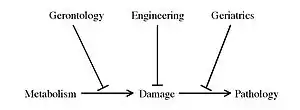Strategies for Engineered Negligible Senescence
Strategies for Engineered Negligible Senescence (SENS) is the term coined by British biogerontologist Aubrey de Grey for the diverse range of regenerative medical therapies, either planned or currently in development, for the periodical repair of all age-related damage to human tissue with the ultimate purpose of maintaining a state of negligible senescence in the patient, thereby postponing age-associated disease for as long as the therapies are reapplied.[1]
The term "negligible senescence" was first used in the early 1990s by professor Caleb Finch to describe organisms such as lobsters and hydras, which do not show symptoms of aging. The term "engineered negligible senescence" first appeared in print in Aubrey de Grey's 1999 book The Mitochondrial Free Radical Theory of Aging.[2] De Grey called SENS a "goal-directed rather than curiosity-driven"[3] approach to the science of aging, and "an effort to expand regenerative medicine into the territory of aging".[4]
Framework

The ultimate objective of SENS is the eventual elimination of age-related diseases and infirmity by repeatedly reducing the state of senescence in the organism. The SENS project consists in implementing a series of periodic medical interventions designed to repair, prevent or render irrelevant all the types of molecular and cellular damage that cause age-related pathology and degeneration, in order to avoid debilitation and death from age-related causes.[1]
The Strategies
The following table as transcribed from the SENS's website details the following major ailments and preventative strategies:[5]
| Issue | Countermeasure |
|---|---|
| Extracellular aggregates | Immunotherapeutic clearance |
| Accumulation of senescent cells | Senescence marker-targeted toxins, Immunotherapy |
| Extracellular matrix stiffening | AGE-breaking molecules,tissue engineering |
| Intracellular aggregates | Novel lysosomal hydrolases |
| Mitochondrial mutations | Allotopic expression of 13 proteins |
| Cancerous cells | Removal of telomere-lengthening machinery |
| Cell loss, tissue atrophy | Stem cells and tissue engineering |
Technology Review controversy
In February 2005, Technology Review, which is owned by the Massachusetts Institute of Technology, published an article by Sherwin Nuland, a Clinical Professor of Surgery at Yale University and the author of "How We Die",[6] that drew a skeptical portrait of SENS, at the time de Grey was a computer associate in the Flybase Facility of the Department of Genetics at the University of Cambridge.
During June 2005, David Gobel, CEO and Co-founder of Methuselah Foundation offered Technology Review $20,000 to fund a prize competition to publicly clarify the viability of the SENS approach. In July 2005, Pontin announced a $20,000 prize, funded 50/50 by Methuselah Foundation and MIT Technology Review, open to any molecular biologist, with a record of publication in biogerontology, who could prove that the alleged benefits of SENS were "so wrong that it is unworthy of learned debate."[7] Technology Review received five submissions to its Challenge. In March 2006, Technology Review announced that it had chosen a panel of judges for the Challenge: Rodney Brooks, Anita Goel, Nathan Myhrvold, Vikram Sheel Kumar, and Craig Venter.[8] Three of the five submissions met the terms of the prize competition. They were published by Technology Review on June 9, 2006. On July 11, 2006, Technology Review published the results of the SENS Challenge.[9]
In the end, no one won the $20,000 prize. The judges felt that no submission met the criterion of the challenge and discredited SENS, although they unanimously agreed that one submission, by Preston Estep and his colleagues, was the most eloquent. Craig Venter succinctly expressed the prevailing opinion: "Estep et al. ... have not demonstrated that SENS is unworthy of discussion, but the proponents of SENS have not made a compelling case for it."[9] Summarizing the judges' deliberations, Pontin wrote that SENS is "highly speculative" and that many of its proposals could not be reproduced with the scientific technology of that period. Myhrvold described SENS as belonging to a kind of "antechamber of science" where they wait until technology and scientific knowledge advance to the point where it can be tested.[9][10]
SENS Research Foundation
The SENS Research Foundation is a non-profit organization co-founded by Michael Kope, Aubrey de Grey, Jeff Hall, Sarah Marr and Kevin Perrott, which is based in California, United States. Its activities include SENS-based research programs and public relations work for the acceptance of and interest in related research.
See also
| Wikiversity has learning resources about Strategies for Engineered Negligible Senescence |
- Aging
- Aging-associated diseases
- American Academy of Anti-Aging Medicine
- Biological immortality
- DNA damage theory of aging
- Eternal youth
- Genetics of aging
- Geroprotector
- Immortality
- Indefinite lifespan
- Longevity
- Maximum life span
- Protoscience
- Rejuvenation Research
- Senolytics
- Timeline of senescence research
References
- de Grey, Aubrey; Rae, Michael (September 2007). Ending Aging: The Rejuvenation Breakthroughs that Could Reverse Human Aging in Our Lifetime. New York, NY: St. Martin's Press, 416 pp. ISBN 0-312-36706-6.
- de Grey, Aubrey (November 2003). The Mitochondrial Free Radical Theory of Aging. Austin, Texas: Landes Bioscience. ISBN 1-58706-155-4.
- Bulkes, Nyssa (March 6, 2006). "Anti-aging research breakthroughs may add up to 25 years to life". The Northern Star. Northern Illinois University (DeKalb, USA).
- . "Age-Related Diseases: Medicine's Final Adversary?". Huffington Post Healthy Living.
- "Intro to SENS Research". SENS Research Foundation. Retrieved 2020-08-18.
- Nuland, Sherwin (1994). How We Die: Reflections on Life's Final Chapter. New York: Knopf Random House. ISBN 0-679-41461-4.
- Pontin, Jason (July 28, 2005). "The SENS Challenge". Technology Review.
- Pontin, Jason (March 14, 2006). "We've picked the judges for our biogerontology prize". Technology Review.
- Pontin, Jason (July 11, 2006). "Is Defeating Aging Only A Dream?". Technology Review.
- Garreau, Joel (October 31, 2007). "Invincible Man". Washington Post.
